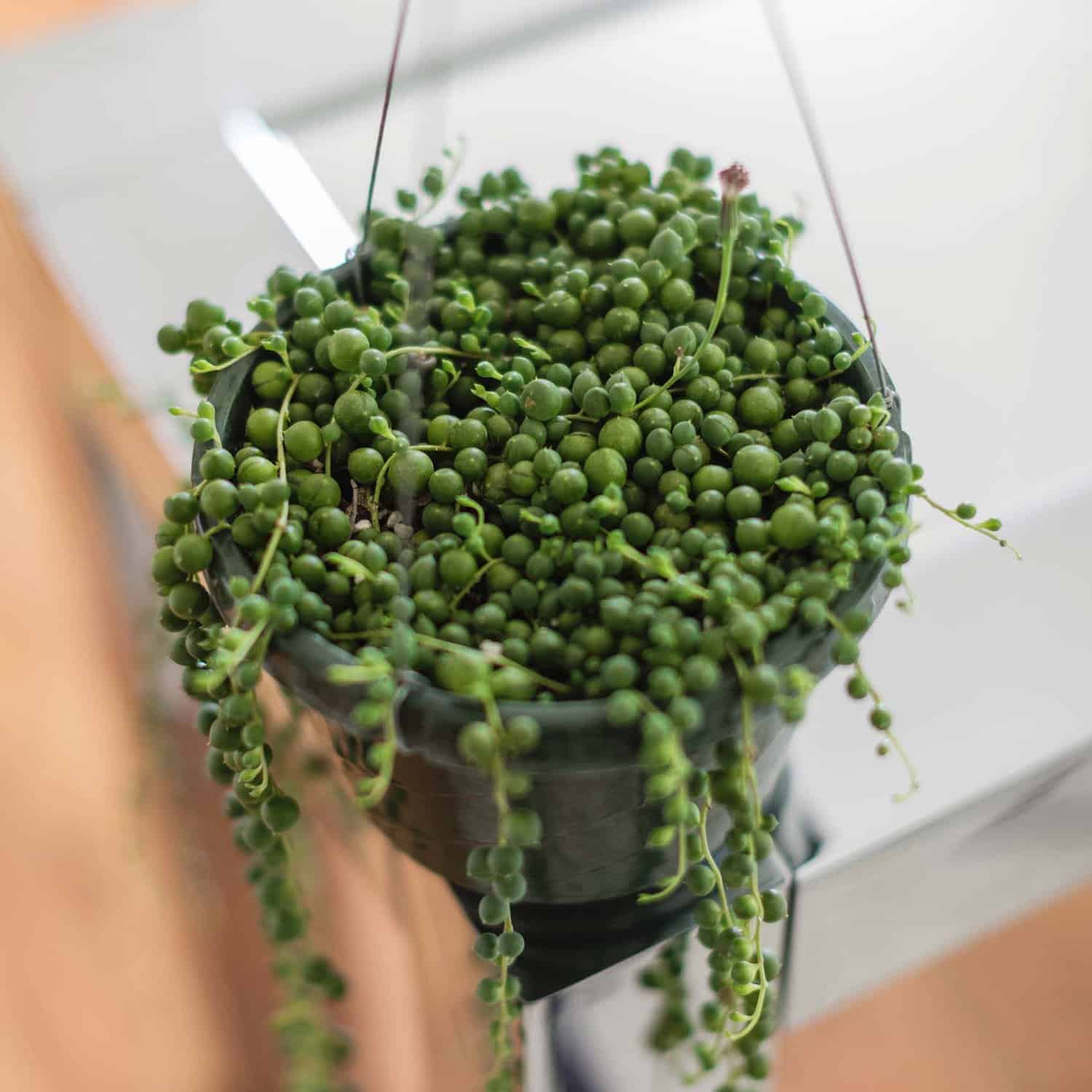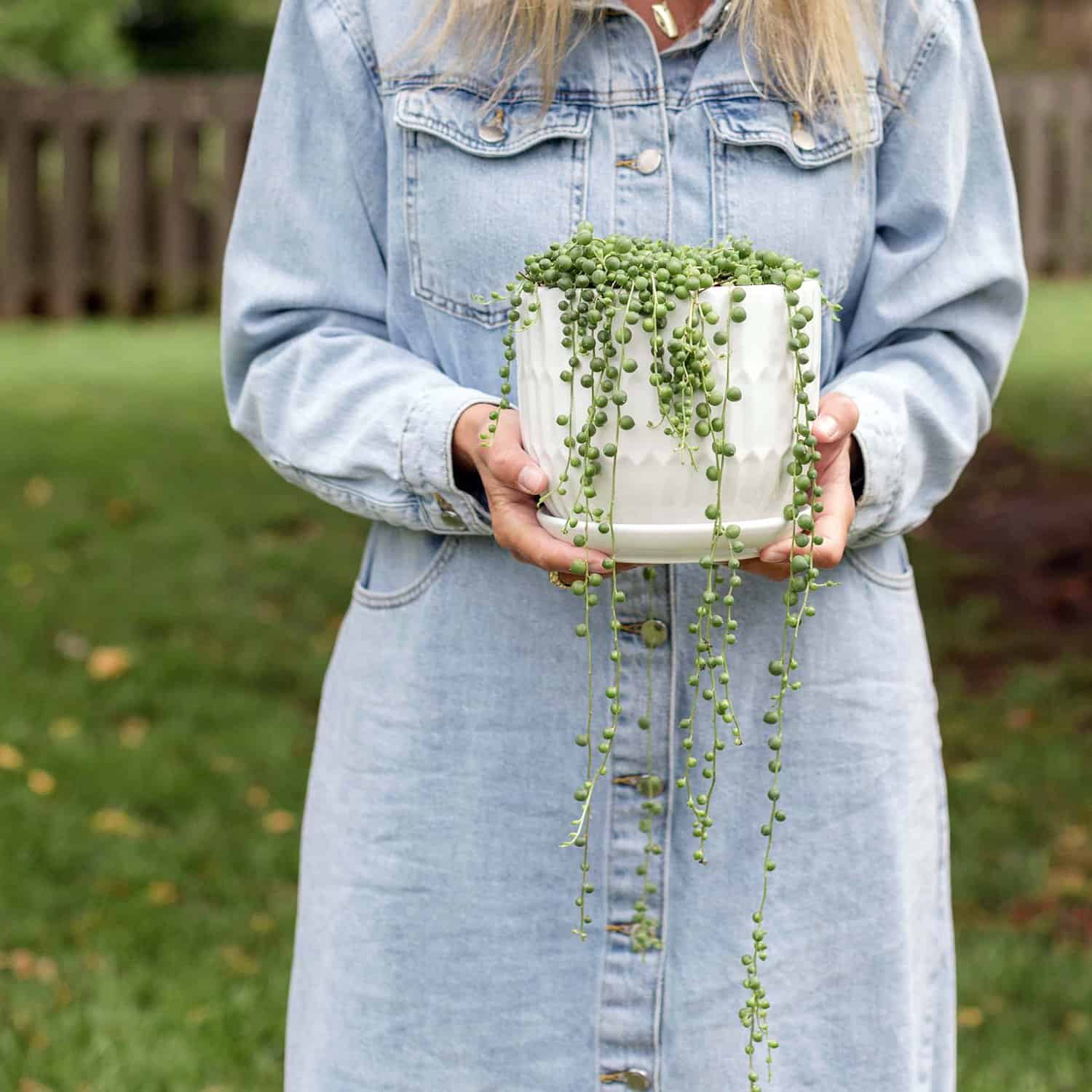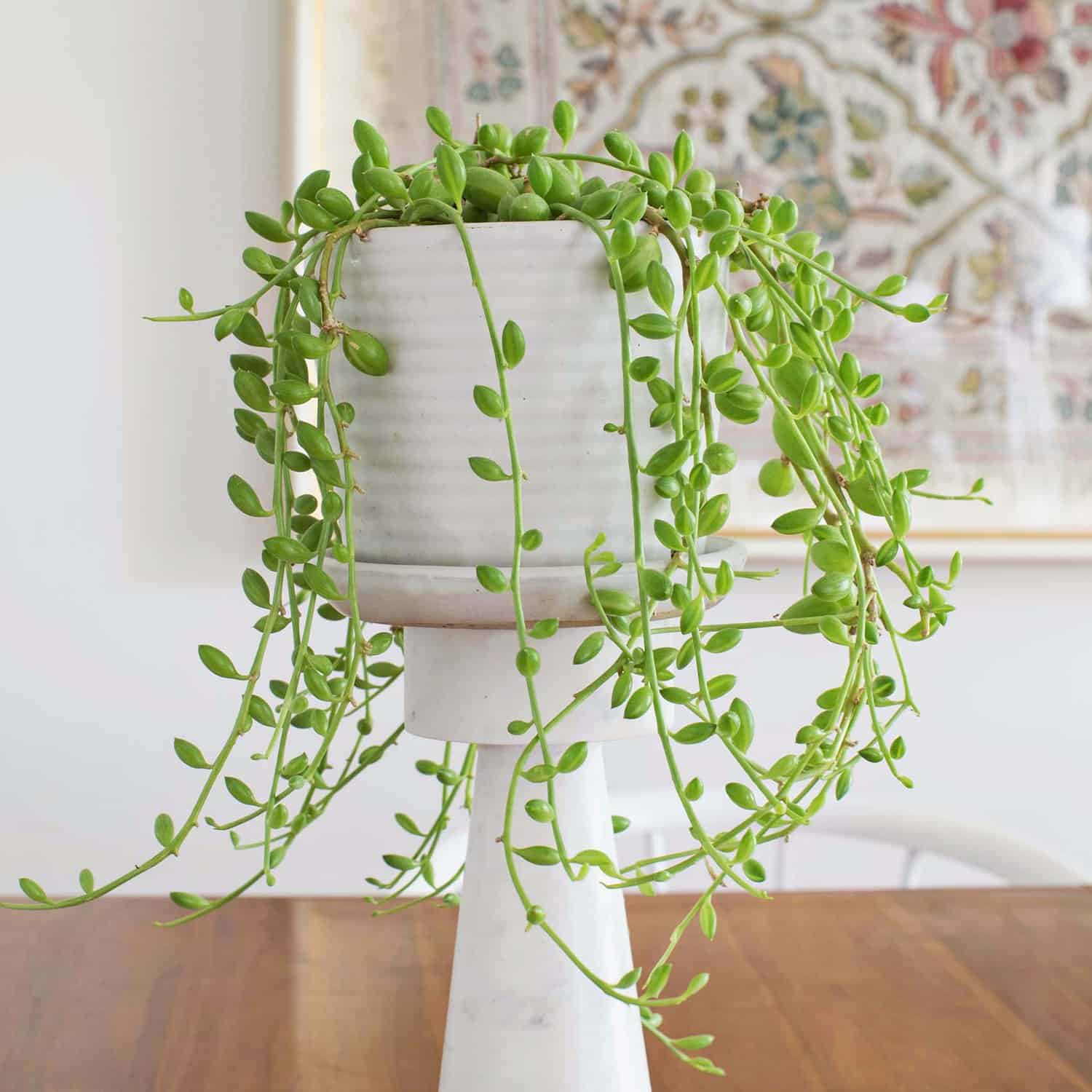The String of Pearls, also known as the Curio Rowleyanus, is a unique trailing succulent. If I were to name one plant that has my heart, it would be this one. I think it is the most beautiful houseplant!
The plant originates from the southern tip of Africa, and its uniqueness makes this plant a favorite for plant parents. String of Pearls is a creeping succulent that has green balls for leaves (they look like peas)!
In this post, I am going to share some tips on caring for a string of pearls. I will also share some other species of this plant family at the end of the post.
Related: Love plants? Learn how to care for Rubber Trees, Snake Plants, Chinese Money Plants, Fiddle Leaf Figs, Air Plants, and Monstera Plants.

Potting
When you get a string of pearls from a garden store, what’s next? You will need some well-draining succulent soil mix, which you can buy at most garden centers. It has a mix of soil and sand.
The sand helps aid in soil aeration and lets the water flow more freely through the soil. I also like to put some extra perlite in my succulent soil.
Perlite is found in nature and is actually formed by volcanic eruptions. Perlite is great for helping your soil drain the water out faster, as well.

For pots, get one that is about the same size (definitely not smaller) or a tiny bit bigger than the plastic pot that it came in (it will likely come in a plastic hanging basket). I like to use a terracotta pot or an earthenware pot.

The most important aspect when choosing a pot is that it must have a drainage hole so the water has a way of escaping. If the water cannot escape the pot, then there is a good chance the plant could die due to being waterlogged.
Next, mix up your soil with a couple of scoops of perlite and have it ready to go. Take your pot and put a little soil in the bottom.
Next, carefully remove your string of pearls from the pot by gently placing your hand on top of the plant, slightly wiggle the pot until the plant pops out.
You might lose a few pearls (leaves) in this process, but that’s OK! Place your plant in the pot and make sure the plant sits about even with the pot’s rim. I put the roots about 1 centimeter under the rim and the pearls are all on top of the rim.
Don’t let the plant lay lower than the pot’s rim because water can pool on top of the leaves.

The plant loves to drink up light and trail over the edge of the pot. Once you have the crown of the plant placed correctly, take the extra dirt and backfill around the plant. I like using a chopstick to push down the dirt around the plant.
Once you’re done backfilling the dirt, the string or pearls will likely need untangling (especially if you have a long one). Be patient during this process. If I slightly tug on a stem it could snap!
Carefully look for a whole stem and gently untangle it so it lays draping over the pot. I go around the whole plant until all stems are untangled. You will probably lose a few more pearls during this process too, but it’s OK!
Note: Even though this plant has lots of amazing qualities, string of pearls plants are toxic for humans and pets if ingested. If a bead (leaf) falls off a stem onto the floor, then I will quickly pick it up so my dog does not eat them.

Light
The string of pearls likes a bright and sunny environment in your home. An east or west facing window will work great. I place mine right near a window so they can drink up lots of light.
Try to avoid placing it near any vents or drafty parts of your home (near a door opening up in the winter, etc.). It will not like any kind of extreme air temperatures blowing on it. During the warmer summer months, you can also put it under a sun porch or covered porch to soak up bright indirect light.
Direct sunlight could burn your plant, so try to avoid it sitting in the sun for hours on end or they will get scorched. When temps begin to drop, bring your plant indoors.
Before you bring it indoors, always check for pests or bugs. When I was bringing in my succulents from our covered porch at the end of summer, I found a baby black widow hiding under a leaf. This has happened to me again a couple of years later!
My lesson was learned quickly so thoroughly inspect any plant before you bring it back into your home.
Watering
Figuring out a watering routine and getting to know your plant’s schedule will really pay off. String of pearls do not like to get soaked or sit in water for long periods of time. I like to say that I “moisten” my string of pearls instead of watering them.
This helps remind me that they don’t need excessive water. The plant has a shallow root system, so generally the top half of my string of pearls pot needs water. I use a small vessel with water in it and lightly water over the whole top of the plant.
Overwatering the string of pearls will be the biggest killer to your plant. You can tell if a plant is overwatered by the leaves looking squishy or they lose their deep green color and become a bit translucent and soft.
If you are shopping for a new string of pearls, be mindful of this. You’ll want a plant with deep green pearls and soil that is not waterlogged.

Not sure when to water your string of pearls? It really depends on where you live and humidity levels. Dryer climates will require more water and vice versa.
You can test the soil by sticking your finger in a part of the soil to check moisture levels or lift your pot to see if it has any weight from holding water.
Make sure your water temp is lukewarm to cool (think of rainwater temp). The string of pearls will not tolerate extreme cold or hot temps when watering.
They love to be watered frequently in the spring and summer months (during its growing season), but back off on frequent watering in the fall/winter months. The string of pearls likes to dry out but not be bone dry.
How can you tell when it is bone dry? The dirt around the circumference of the pot will pull away from the pot. If this has happened, no worries, give it a watering and try to water your plant sooner next time to avoid the dirt drying out too much.
If this happened multiple times, it could affect your leaves and plant’s root health. Another aspect of root health is root rot. This can be detrimental to your plant.
Root rot happens when the roots stand in water too long and they eventually rot and die. It can be a very sad and slow death for a string of pearls.
If you suspect that your plant has been sitting in water for too long and it might have root rot, pull it out of the pot to inspect the roots. If the roots are firm and grayish white, that is great. If they are mushy and look blackish, then your plant likely has root rot.
If it’s not too far gone, you can try to snip the dead roots off and leave the healthy, firm ones. Placing the plant in fresh (not waterlogged soil) will help as well.
What is the best kind of water to use? If you are using tap/city water, you can leave your tap water out in an open container for 24 hours so some of the chemicals evaporate. After 24 hours, the water is cleaner and healthier for your plant!
Fluoride and chlorine can build up in your string of pearls root system, so this method of leaving your water out will pay off in the long run. Using filtered water or collected rain water (if you can) is a great option, too!
If you have well water, then your plant will love that. My friends who have well water have THE best plants.

Propagating
You can propagate the string of pearls three ways! The first way is by using water. First, find a healthy stem. I like to use stems that are at least 4-5 inches.
Using clean scissors or cutting shears, cut your stem. Remove any beads about 1.5-2 inches from the bottom of the cutting.
Leave the stem laying out for 24 hours so the fresh cut on the end of the stem can form a callus. Make sure it stays out of any sunlight during this healing period.
After 24 hours, place your fresh cutting in water. The side of the cutting with the removed leafs can be placed in the water. Keep the remaining pearls above the water line.
Be sure to change water anytime it gets cloudy and rinse out your vessel. Place in a sunny spot in your home. After 3-4 weeks you should see little roots sprouting from the cutting!

Wait until the roots are at least 1 inch long before you plant it in dirt. Once it is ready to be potted, use a small terra-cotta or clay pot with good draining cactus/succulent soil.
I like to use a chopstick to create little holes for the newly rooted plant. Moisten lightly and your plant should start growing.
The next way to propagate is by using dirt. Using the same methods as above, you will snip your plant, wait 24 hours, and instead of placing it in water, place your plant in soil (well draining, succulent soil).
Use a chopstick (or pencil) to create a fresh hole for your new cutting, tuck the dirt around the plant. I like to mist my plant to keep the soil slightly moist and not bone dry.
After about three weeks, I give the plant a very gentle tug to see if it is rooting. If the new cutting stays in place, then I know new roots are forming. This is always exciting! If your plant has started to form roots, then it is ready for a watering.
Another way to propagate your string of pearls is by layering. I find this approach to be the most effective. Take a fresh pot of succulent soil, mist it, and then take a good long cutting from your string of pearls. Swirl or coil the cutting over the top of the dirt on the pot.
Fertilizing
I like to fertilize my plant once a month during the growing season (spring and summer) using a balanced fertilizer. I use half of the manufacturer’s recommended rate when I mix my fertilizer.
I love liquid fertilizer because it mixes so easily with the water and I don’t have to worry about it not being evenly distributed in my plants.

One thing I love about this species of plant is the different varieties. Pictured above is “String of Turtles”—the turtles look like little turtles backs. “String of Watermelons” are plump and their leaves resemble a watermelon (pictured below).

Aren’t they unique and whimsical? I hope you enjoy these plants as much as me! -Janae
